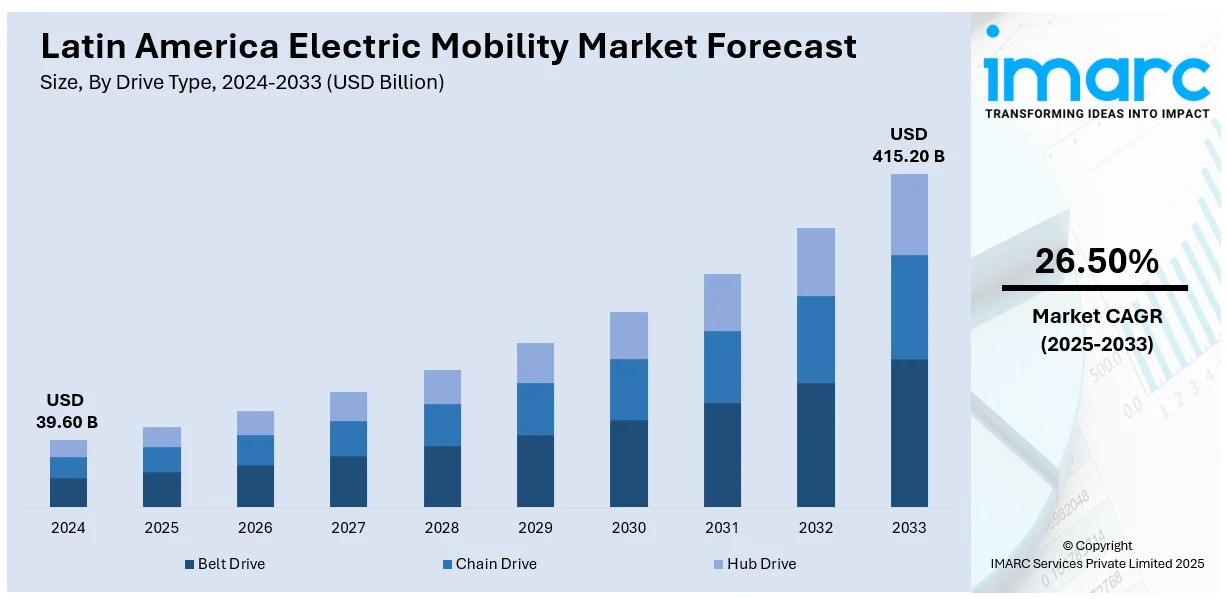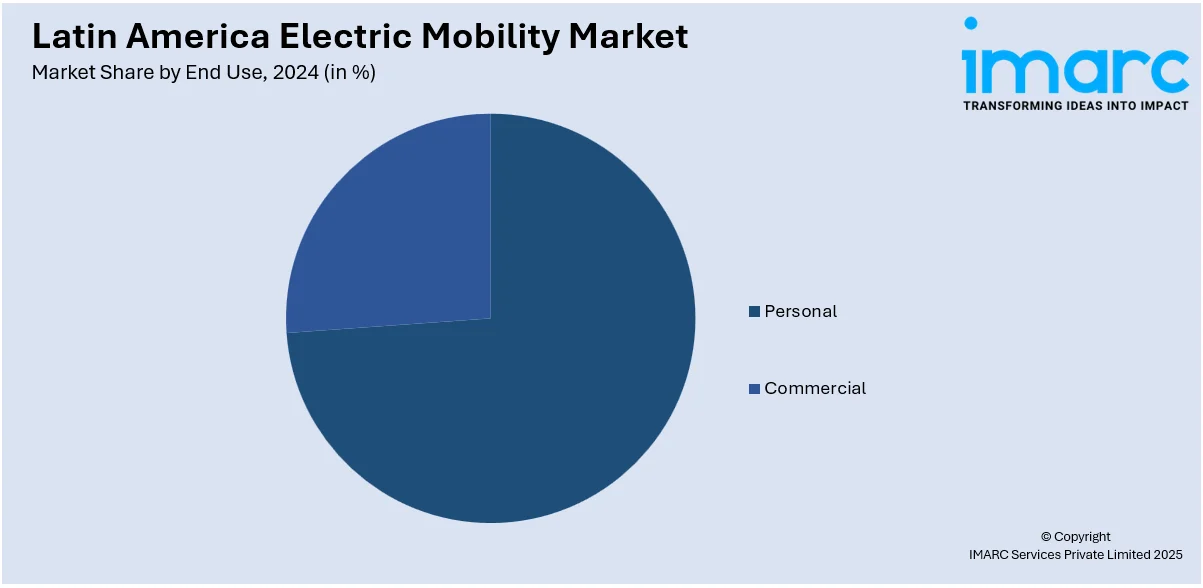
Latin America Electric Mobility Market Size, Share, Trends and Forecast by Drive Type, End-Use, Battery, and Region, 2025-2033
Latin America Electric Mobility Market Overview:
The Latin America electric mobility market size reached USD 39.60 Billion in 2024. Looking forward, IMARC Group expects the market to reach USD 415.20 Billion by 2033, exhibiting a growth rate (CAGR) of 26.50% during 2025-2033. The Latin America electric mobility market share is rapidly expanding due to the implementation of various government incentives, increased environmental concerns in the region, rapid urbanization in Latin American cities, expanded charging infrastructure, and substantial technology improvements.
|
Report Attribute
|
Key Statistics
|
|---|---|
|
Base Year
|
2024 |
|
Forecast Years
|
2025-2033
|
|
Historical Years
|
2019-2024
|
| Market Size in 2024 | USD 39.60 Billion |
| Market Forecast in 2033 | USD 415.20 Billion |
| Market Growth Rate 2025-2033 | 26.50% |
Latin America Electric Mobility Market Trends:
Government Incentives
Government incentives are also driving the uptake of electric vehicles (EVs) in Latin America. Governing agencies in the region are enacting policies that render electric mobility more economically viable for individuals and companies. Some of these incentives include tax cuts, exemptions from import duties, and subsidies on the purchase of EVs. A number of governments in the region are also launching programs to encourage the electrification of public transport fleets. Additionally, some Latin American nations are formulating policies to facilitate the installation of charging infrastructure, which in turn encourages the adoption of electric mobility. The combination of economic incentives, positive legislation, and government-driven infrastructure development is making the Latin America electric mobility market growth stronger.

Environmental Concerns
Rising environmental issues are a leading catalyst for growth in electric mobility in Latin America. Air pollution and increasing carbon emissions are huge issues in the region's densely populated cities, where fossil fuel-powered automobiles account for much of the dirty air. Governments and green organizations are more and more seeing the need to address the situation, and electric cars are being viewed as an essential part of the solution. Electric vehicles (EVs) have zero tailpipe emissions, reducing air pollution in cities considerably. Moreover, as Latin American countries move towards cleaner energy sources like wind, solar, and hydropower, the overall carbon footprint of electric mobility is declining further. This change in behavior, coupled with regulatory compulsions, is compelling businesses as well as individuals to switch to electric mobility.
Rapid Urbanization
Urbanization is redefining the face of transport in Latin America, making electric mobility an economic solution to most of the challenges confronting expanding cities. Latin America boasts one of the highest urbanization rates in the world, with more and more people flocking to cities in search of improved economic opportunities. This high-speed urbanization is resulting in traffic congestion, air pollution, and increased need for efficient transport systems. Electric vehicles (EVs) are increasingly necessary in alleviating traffic congestion as well as emission reduction in such high-density urban areas. The urban planners are also starting to develop infrastructure with Latin America electric mobility market outlook by the addition of public charging points in primary urban centers.
Latin America Electric Mobility Market Segmentation:
IMARC Group provides an analysis of the key trends in each segment of the market, along with forecasts at the country level for 2025-2033. Our report has categorized the market based on drive type, end-use, and battery.
Drive Type Insights:
- Belt Drive
- Chain Drive
- Hub Drive
The report has provided a detailed breakup and analysis of the market based on the drive type. This includes belt drive, chain drive, and hub drive.
End-Use Insights:

- Personal
- Commercial
A detailed breakup and analysis of the market based on the end-use have also been provided in the report. This includes personal and commercial.
Battery Insights:
- Lead-acid Battery
- Lithium-ion Battery
- Others
A detailed breakup and analysis of the market based on the battery have also been provided in the report. This includes lead-acid battery, lithium-ion battery, and others.
Regional Insights:
- Brazil
- Mexico
- Argentina
- Colombia
- Chile
- Peru
- Others
The report has also provided a comprehensive analysis of all the major regional markets, which include Brazil, Mexico, Argentina, Colombia, Chile, Peru, and others.
Competitive Landscape:
The market research report has also provided a comprehensive analysis of the competitive landscape. Competitive analysis such as market structure, key player positioning, top winning strategies, competitive dashboard, and company evaluation quadrant has been covered in the report. Also, detailed profiles of all major companies have been provided.
Latin America Electric Mobility Market News:
- In July 2024, LOBO EV Technologies, a leading manufacturer of e-bicycles, e-mopeds, e-tricycles, and electric off-highway shuttles, opened a new office in Suriname to strengthen its presence in Latin America. This strategic expansion aligns with the region’s growing demand for sustainable electric mobility solutions, supporting the shift toward cleaner transportation.
- In August 2024, Odysse Electric and Sun Mobility joined forces to advance electric mobility across Africa, Latin America, and Southeast Asia. This collaboration will utilize Sun Mobility’s battery swapping platform to improve the accessibility and convenience of Odysse Electric’s Vader SM, implementing a Battery-as-a-Service (BaaS) model for seamless energy solutions.
Latin America Electric Mobility Market Report Coverage:
| Report Features | Details |
|---|---|
| Base Year of the Analysis | 2024 |
| Historical Period | 2019-2024 |
| Forecast Period | 2025-2033 |
| Units | Billion USD |
| Scope of the Report | Exploration of Historical Trends and Market Outlook, Industry Catalysts and Challenges, Segment-Wise Historical and Future Market Assessment:
|
| Drive Types Covered | Belt Drive, Chain Drive, Hub Drive |
| End-Uses Covered | Personal, Commercial |
| Batteries Covered | Lead-acid Battery, Lithium-ion Battery, Others |
| Regions Covered | Brazil, Mexico, Argentina, Colombia, Chile, Peru, Others |
| Customization Scope | 10% Free Customization |
| Post-Sale Analyst Support | 10-12 Weeks |
| Delivery Format | PDF and Excel through Email (We can also provide the editable version of the report in PPT/Word format on special request) |
Key Questions Answered in This Report:
- How has the Latin America electric mobility market performed so far and how will it perform in the coming years?
- What is the breakup of the Latin America electric mobility market on the basis of device type?
- What is the breakup of the Latin America electric mobility market on the basis of end-use?
- What is the breakup of the Latin America electric mobility market on the basis of battery?
- What are the various stages in the value chain of the Latin America electric mobility market?
- What are the key driving factors and challenges in the Latin America electric mobility market?
- What is the structure of the Latin America electric mobility market and who are the key players?
- What is the degree of competition in the Latin America electric mobility market?
Key Benefits for Stakeholders:
- IMARC’s industry report offers a comprehensive quantitative analysis of various market segments, historical and current market trends, market forecasts, and dynamics of the Latin America electric mobility market from 2019-2033.
- The research report provides the latest information on the market drivers, challenges, and opportunities in the Latin America electric mobility market.
- Porter's five forces analysis assist stakeholders in assessing the impact of new entrants, competitive rivalry, supplier power, buyer power, and the threat of substitution. It helps stakeholders to analyze the level of competition within the Latin America electric mobility industry and its attractiveness.
- Competitive landscape allows stakeholders to understand their competitive environment and provides an insight into the current positions of key players in the market.
Need more help?
- Speak to our experienced analysts for insights on the current market scenarios.
- Include additional segments and countries to customize the report as per your requirement.
- Gain an unparalleled competitive advantage in your domain by understanding how to utilize the report and positively impacting your operations and revenue.
- For further assistance, please connect with our analysts.
 Request Customization
Request Customization
 Speak to an Analyst
Speak to an Analyst
 Request Brochure
Request Brochure
 Inquire Before Buying
Inquire Before Buying




.webp)




.webp)












